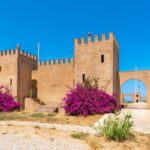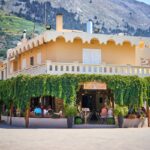The Greek Islands comprise more than 6,000 islands and islets covering much of the eastern Mediterranean. Only about 230 Greek islands are inhabited and, of these, just 80 or so have more than 100 permanent inhabitants.
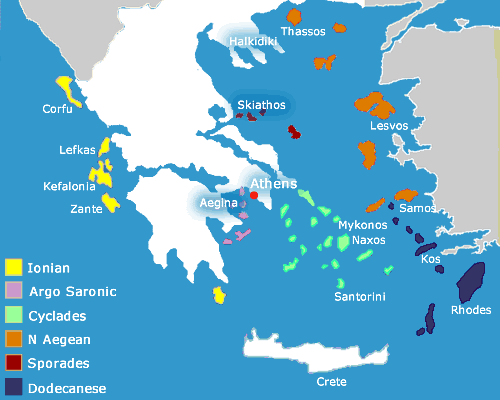
The Greek islands are traditionally grouped into six major clusters:
Ionian: Found off the north-west coast of mainland Greece in the Ionian Sea these contain the popular holiday islands of Corfu, Kefalonia and Zante.
Saronic: These lie in the Saronic gulf near Athens and the main islands here are Aegina and Poros.
Cyclades: A large, dense group of islands in the central Aegean Sea that include the popular holiday islands of Mykonos and Santorini.
North Aegean: A loose island group to the north-east of Greece. The main holiday destinations here are Thassos, Lesvos and Samos.
Sporades: A small, tightly-knit island group just off the east coast of Greece that include Skiathos and Skopelos.
Dodecanese: A long and loose string of islands that roughly follow the Turkish coast and include the popular holiday beaches on Kos and Rhodes.
Each island group has its own flavour and each island within a group has its own character. The Ionian, for example is characterised by lush greenery, the Cyclades are ‘typical’ Greek islands of whitewashed cube houses on windy, rocky outcrops; the Dodecanese, close to the Turkish mainland, are the hottest, particularly in the south.
Ionian Islands map
The Ionian Islands are one of the most popular holiday destinations in Greece. There are about 25 islands in this group but only a handful are of interest to the average holidaymaker. Corfu, Kefalonia, Zante and, more recently Lefkas, have all become big hitters in the Greek island holiday stakes.
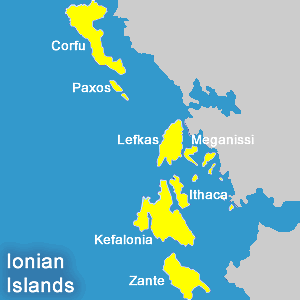
The smaller islands of Paxi and Ithaca tend to appeal to those seeking a quiet retreat but they are relatively difficult to get to as inter-island ferries are not as frequent as in other island groups. Islets such as Antipaxos, Kalamos and Skorpios are suitable only for day trip visits.
The Ionian islands are the closest to the UK for flight times and have lush, green interiors thanks to relatively heavy winter rains – Corfu gets twice as much winter rain as London.
The southern Ionian islands have suffered heavily from earthquake damage and little is left of their architectural heritage. The prevailing historical influence is from the West – the Venetians, French and British. Today, the tourists are mostly British and Italian. And although popular with package tour operators offering rock-bottom prices there is plenty of room in the Ionian island for those who shun mass tourism.
Even the most popular Ionian islands of Corfu and Zante have their quiet, hideaway corners and some of the outlying islets, such as Ithaca and Meganissi, are heavenly, tranquil backwaters.
Saronic Islands map
The Saronic Islands are found in the Saronic Gulf just to the south of the Greek capital of Athens. The main islands in this group are Aegina, Agistri, Poros, Methana and Salamis.
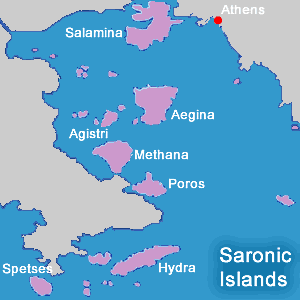
The islands of Hydra and Spetses are often included in this group although they are not in the Saronic Gulf proper but closer to the Argolic Gulf. For this reason the group is sometimes referred to as the Argo-Saronic.
The main inhabited islands of the Saronic group are Salamis (the famous site where the ancient Greek navy defeated the Persians), Aegina, Angistri, and Poros. Salamis, despite its romantic history is now virtually an industrial suburb of Piraeus and, although it has a couple of beaches, has few foreign tourists.
Many mainland Greeks have holiday homes in the Saronic Islands, which are regularly served by ferries from Piraeus and the Peloponnese.
Cyclades Islands map
The Cyclades Islands are home to many of the most popular Greek islands. The Cyclades are found in the central and southern area of the Aegean Sea and is composed of 39 islands of which 24 are inhabited.
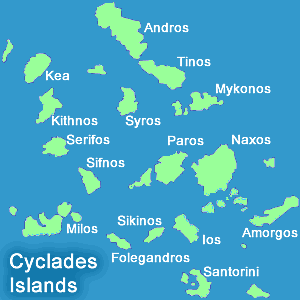
The Cyclades have islands for all tastes – from the spectacular volcanic scenery of Santorini to the jet-set beauty spots on Mykonos, the party island of Ios to the gentle rolling hills of Paros. Other notable Cycladic islands include Amorgos, Andros, Folegandros, Naxos and Syros.
Mykonos and Santorini are must-stop spots for Mediterranean cruise liners and bring in a regular daily fistful of credit card carrying tourists while the westernmost islands see only the most ardent independent island hoppers.
The lack of direct flights to many islands and the vicissitudes of ferry links keep most of the big tour operators at bay. That said the Cyclades are the ferry hub of the Greek islands and so are a favourite for both island hopping holidays and for holiday yacht flotillas.
Mykonos and Santorini have the only international airports and many tourists fly in here to begin their Greek island hopping holidays.
North Aegean Islands map
The North Aegean Islands, sometimes called the North-east Aegean islands are a loose assortment of 12 islands located to the north of the Aegean Sea and just off the Turkish mainland. The best known are Thassos, Lesvos and Samos but others include Lemnos, Ikaria, and Samothrace.
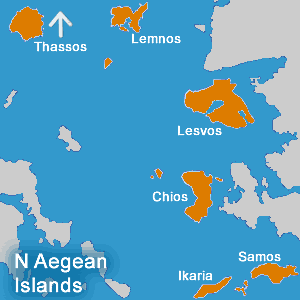
Many of the north Aegean islands are large, some distance apart and with infrequent ferry connections so calling them a group is a little misleading and they are only really connected for Greek administrative purposes.
They may be a little off the main tourist trail but they are still well developed with Samos and Lesvos the top holiday spots, thanks to good airports, but closely followed these days by Thassos which has airport links are nearby Kavala on the mainland.
Rugged Ikaria and kidney-shaped Chios are off the package tourist map but offer very good beaches and great walking while both Lemnos (or Limnos) and Samothraki remain largely untouched by tourism.
Sporades Islands map
The Sporades Islands are located off the eastern shore of mainland Greece near the Pelion region of mainland Greece and not far from the port of Volos. The Sporades has 11 islands of which four are permanently inhabited: Skiathos, Skopelos, Alonissos and Skyros.
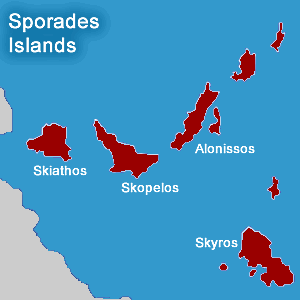
Most holiday visitors arrive through Skiathos airport and Skiathos is a major holiday destination. There are package holidays galore to Skiathos which boast 60 or more sandy beaches while Skopelos and Alonissos attract the more up-market holidaymaker.
All the Sporades are a favourite of the flotilla sailing companies and there are daily ferries from Volos and Agios Konstantinos. Ferry boats travel regularly between Skiathos, Skopelos and Alonissos. Skyros shuns the package tourist trade and can only be reached from Evia and the mainland.
Much of the sea around the Sporades, notably the islets to the north of Alonissos, form a marine park established mainly to protect the endangered Mediterranean monk seal and other wild animals.
Dodecanese Islands map
The Dodecanese Islands is the name given to the group of islands that hug the Turkish coast from Rhodes in the south to Patmos in the north. Dodecanese means ‘twelve’ and there are 12 major islands that give the group the name but in fact the Dodecanese consists of 163 islands in total, of which 26 are inhabited.
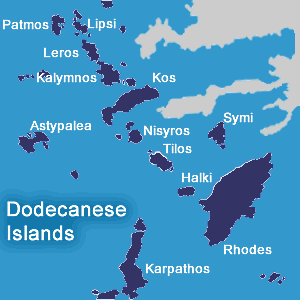
Many of the Dodecanese islands have suffered turbulent histories at the hands of various invaders, notably the Turks, and there is a strong Ottoman influence everywhere. The premier holiday island in this chain is Rhodes, the capital of the archipelago and by far the biggest island in the group with good air and sea links.
Rhodes and Kos both have international airports and both ferries and hydrofoils ply a regular route through the Dodecanese. Apart from Rhodes the main package holiday island is Kos, with Kalymnos, Patmos and Leros popular with independent travellers. Most of the other islands, such as Halki, Symi, Lipsi, Pserimos, Tilos and Nisyros, are popular day trip destinations.

Born and raised on the sun-drenched island of Crete, Sofia Mavromatis is a seasoned traveler and writer with a deep-rooted love for Greece’s vibrant culture, stunning landscapes, and rich history.


